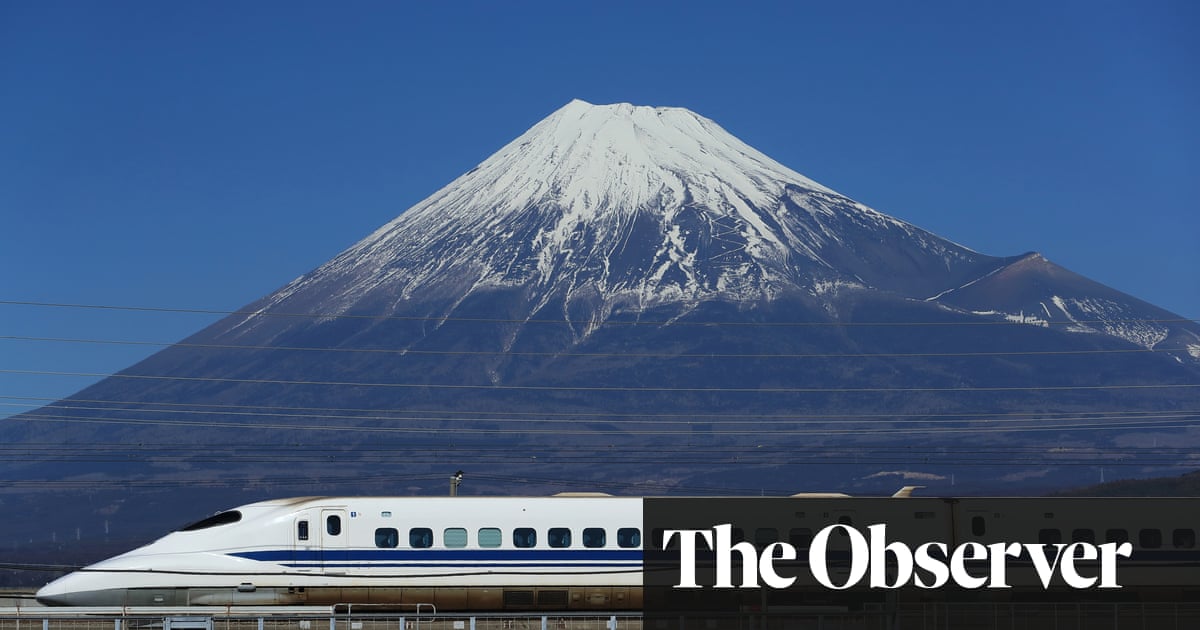At 6am on 1 October 1964, two trains set off in opposite directions in a daring experiment that would quickly turn them into symbols of Japan’s transformation from militarist pariah to global economic powerhouse.
Black-and-white footage shows smartly dressed men, women and children marvelling at the countryside whizzing past their windows, some perhaps trying to calm their nerves at being whisked along at speeds unheard of in rail travel.
Crowds gathered on platforms to watch the two trains reach their destinations, Tokyo and Osaka. Then, like now, they arrived exactly on time, at 10am, depositing their passengers after a 320-mile journey that had once taken almost seven hours but which they had just completed in four.
Six decades on, it is hard to believe that many then viewed the shinkansen – now the jewel in the crown of the country’s public transport infrastructure – as an indulgence. There were protests over the acquisition of land, while critics labelled it an expensive anachronism in a postwar age of prosperity and mobility in which air and road travel would surely reign.
Instead, the shinkansen, commonly known outside Japan as the bullet train, has become a byword for Japanese comfort and efficiency. The network has expanded to cover all four of the country’s main islands – a network of more than 1,800 miles that connects most major cities, taking passengers to their destinations at speeds of up to 200mph.
Mark Schreiber, a longtime resident of Japan, remembers being “thrilled” as an 18-year-old to be making his first bullet train trip, from Tokyo to Kyoto, with his brother and parents in 1965. “The ride was so smooth, the only sensation of speed was watching the scenery fly by,” said Schreiber, who wrote a history of the shinkansen for a Japanese magazine when the service marked its 25th year. “This is a country that really loves its trains, and their pride and enthusiasm has been contagious.”
The shinkansen – literally “new trunk line” – is also a lesson, not least for HS2 planners in Britain, in how to run a high-speed rail service.
The Tokyo-Nagoya-Osaka service alone, known as the Tokaido line, has carried 6.4 billion people, according to Central Japan Railway – while there has not been a single fatality as a result of an accident anywhere on the network. British commuters will be dismayed to learn that the average delay is less than a minute.
The shinkansen’s debut was part of the emergence of a new Japan – a constitutional democracy with a soaring economy and revitalised population, whose readmission into the international community would be completed nine days later by the opening ceremony of the Tokyo Olympics.
“The opening of the Tokaido Shinkansen and the 1964 Olympics become entwined in a powerful symbolic message to the world: Japan is back. But not only is Japan back, it is ready to be a world leader,” said Christopher Hood, reader in Japanese studies at Cardiff University and author of Shinkansen: From Bullet Train to Symbol of Modern Japan.
The service has not rested on its laurels. The travelling time between Tokyo and Osaka has been cut to 2 hours and 22 minutes, at a maximum speed of 178mph. In 1964, it served an average of 60,000 passengers a day; by 2013, it was 424,000.
But the service is marking its 60th year at an uncertain time. The next-generation bullet train has been blighted by delays, rows about its environmental impact and doubts over its appeal in an age of budget air travel.
after newsletter promotion
The Chuo Shinkansen, originally scheduled to open in 2027, will connect Tokyo with the central city of Nagoya in just 40 minutes rather than the current one hour 34 minutes, with trains reaching a maximum speed of more than 300mph.
The resignation this year of a local governor who had led objections to plans for the line to pass through his prefecture has removed one obstacle, but others remain. This month, officials said the presence of soft ground along the proposed route would delay completion of one of the tunnels by more than five years. It is now not expected to go into commercial operation until 2034 at the earliest.
Hood attributes much of the train’s success to its safety record and reliability. “Another aspect is that it connects key cities,” he said. “People in the UK probably don’t appreciate how big Japan really is. In area terms it’s only about 50% bigger than the UK, but it stretches a long way.”
Hood believes other countries would not have built their own high-speed railways had it not been for the shinkansen.
Shigeru Morichi, a transport policy expert and professor emeritus at the National Graduate Institute for Policy Studies in Tokyo, credits the network’s expansion with revitalising the economies of cities located along its lines. “It has expanded the sphere of economic activity, just as the silk road and Roman road-building revolutionised the economy, culture, and civilisation of the time,” said Morichi, who uses the service at least 10 times a year.
Donna Burke, who has been the English-language “voice” of the shinkansen for around two decades, said the train “epitomises what I love about most about Japan – pride in your work, service to others, efficiency and dependability”.







